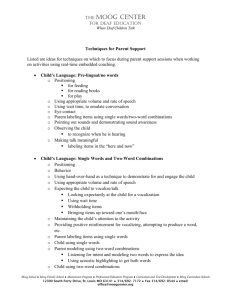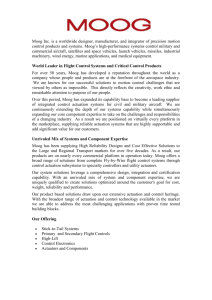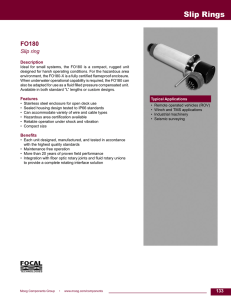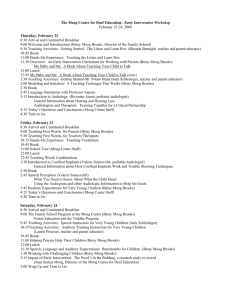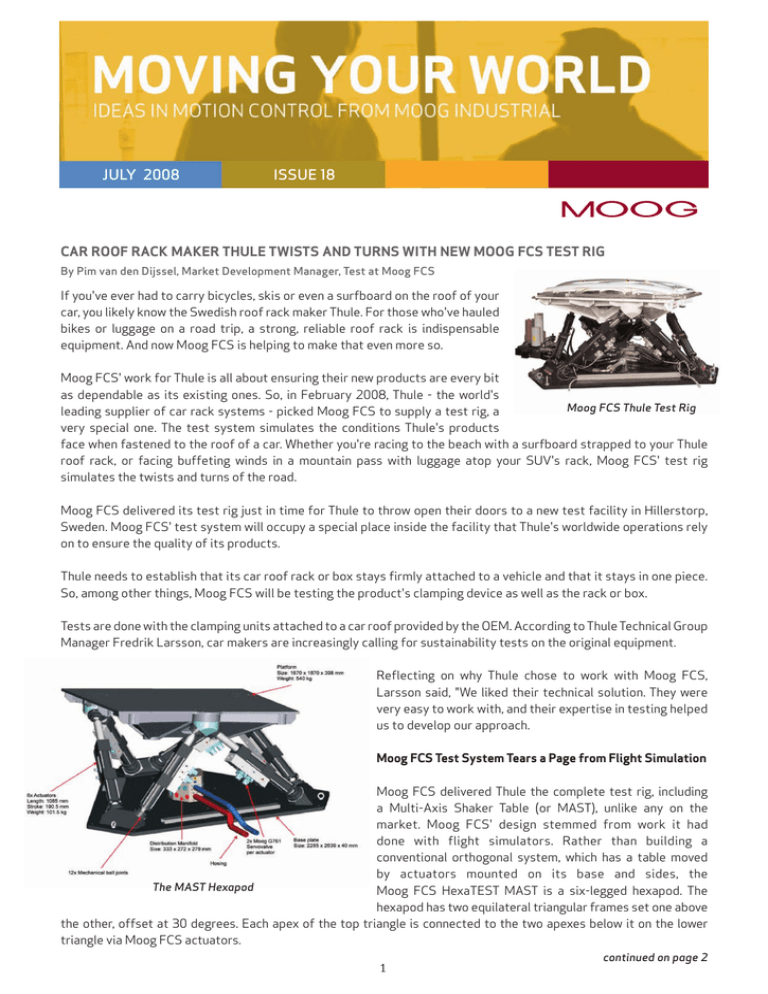
JULY 2008
ISSUE 18
m
CAR ROOF RACK MAKER THULE TWISTS AND TURNS WITH NEW MOOG FCS TEST RIG
By Pim van den Dijssel, Market Development Manager, Test at Moog FCS
If you've ever had to carry bicycles, skis or even a surfboard on the roof of your
car, you likely know the Swedish roof rack maker Thule. For those who've hauled
bikes or luggage on a road trip, a strong, reliable roof rack is indispensable
equipment. And now Moog FCS is helping to make that even more so.
Moog FCS' work for Thule is all about ensuring their new products are every bit
as dependable as its existing ones. So, in February 2008, Thule - the world's
Moog FCS Thule Test Rig
leading supplier of car rack systems - picked Moog FCS to supply a test rig, a
very special one. The test system simulates the conditions Thule's products
face when fastened to the roof of a car. Whether you're racing to the beach with a surfboard strapped to your Thule
roof rack, or facing buffeting winds in a mountain pass with luggage atop your SUV's rack, Moog FCS' test rig
simulates the twists and turns of the road.
Moog FCS delivered its test rig just in time for Thule to throw open their doors to a new test facility in Hillerstorp,
Sweden. Moog FCS' test system will occupy a special place inside the facility that Thule's worldwide operations rely
on to ensure the quality of its products.
Thule needs to establish that its car roof rack or box stays firmly attached to a vehicle and that it stays in one piece.
So, among other things, Moog FCS will be testing the product's clamping device as well as the rack or box.
Tests are done with the clamping units attached to a car roof provided by the OEM. According to Thule Technical Group
Manager Fredrik Larsson, car makers are increasingly calling for sustainability tests on the original equipment.
Reflecting on why Thule chose to work with Moog FCS,
Larsson said, "We liked their technical solution. They were
very easy to work with, and their expertise in testing helped
us to develop our approach.
Moog FCS Test System Tears a Page from Flight Simulation
Moog FCS delivered Thule the complete test rig, including
a Multi-Axis Shaker Table (or MAST), unlike any on the
market. Moog FCS' design stemmed from work it had
done with flight simulators. Rather than building a
conventional orthogonal system, which has a table moved
by actuators mounted on its base and sides, the
The MAST Hexapod
Moog FCS HexaTEST MAST is a six-legged hexapod. The
hexapod has two equilateral triangular frames set one above
the other, offset at 30 degrees. Each apex of the top triangle is connected to the two apexes below it on the lower
triangle via Moog FCS actuators.
1
continued on page 2
continued from page 1
Along with the MAST, Moog FCS supplied the seismic mass, hydraulic infrastructure and safety system. Moog FCS also
provided the data acquisition set-up, including the control cabinet and operator software.
The software package includes Moog FCS' SmarTEST program for system installation, and FasTEST operator software
for running tests to simulate travelling over various road surfaces
Hexapod Technology Bests the Competitors' Performance Specs
Moog FCS examined what the competition could do in terms of acceleration and displacement as a benchmark, and set
out to beat its competitors' performance specifications. While the hexapod is a proven technology, Moog FCS is the
first company to use it in this kind of application.
Moog FCS developed the HexaTEST MAST over four years. The system has six degrees of freedom (DOF) wherein the
table moves in the x,y and z axes, with pitch, roll and yaw. It's complex to control each of the individual degrees of
freedom because a movement along a single axis involves the use of all six actuators. All the actuators have to be
controlled exactly in terms of speed and time, and this is tricky when the table has to vibrate at frequencies between
0.8 to 80 Hz.
As for the hexapod's advantages, there are many. MASTs need to be anchored in a "seismic mass," a massive concrete
block that contains vibrations within the apparatus. The smaller the MAST, the smaller the concrete block needs to be.
The hexapod MAST can operate in a space three to four times smaller than competing designs. Even so, the block for
Thule's hexapod weighs 88 tons. The new unit is also less costly to maintain than orthogonal designs because its six
actuators are alike, so spare parts cost less.
For the MAST to run at very low frequencies, the seismic mass incorporates "active level control." Air springs under the
MAST automatically activate as the mass begins to resonate, compensating for its motion. The MAST can vibrate with
amplitude of over 140 mm along its axes, while maximum rotational displacement is +/- 10 degrees. It supports loads of
up to 990 lbs. And it can run continuously for several days, a period equivalent to hundreds of thousands of road miles.
Moog FCS Test System "Hits" the Road for Thule
In the weeks since buying the test rig, Thule has already carried out several simulations.
"We are very happy with the test system; it's compact, clean and very simple to use," said Larsson.
For example, all of the system's hydraulic hoses are embedded in the concrete floor. The system provides flexibility,
too. Tests are currently done at ambient temperatures. But the rig can operate at various temperatures if Thule decides
to install a climatic room. And if Thule does needs additional support with its newly deployed Moog FCS test system,
Larsson isn't worried.
"If we do run into trouble, Moog FCS has people close by in Gothenburg. We know we can count on them to quickly come
in and help out," Larsson said.
In addition to testing roof racks, Moog FCS has sold its MAST to examine passenger and industrial vehicles. Moog FCS
supplies a number of large OEMs throughout the world with testing solutions. In general, Moog FCS excels in developing
applications that require engineer-to-engineer collaboration to provide a leading-edge solution. Moog FCS' work for
Thule is simply the latest chapter in a collection of stories about innovative testing.
About the Author:
Pim van den Dijssel is Market Development Manager, Test at Moog FCS based in Nieuw Vennep, Netherlands. He is
responsible for developing the aero and auto test businesses in Europe working together with his colleagues in Asia and
America. He holds a Bachelor degree in Industrial Automation from the University of Utrecht, Netherlands, and has over
15 years experience in aero test solutions.
2
HIGH OUTPUT, HIGH RELIABILITY, LOW ENERGY CONSUMPTION IN A PLASTICS PRESS
WITH MOOG MOTION CONTROL TECHNOLOGY
By Volker Treffler, Engineering Manager, Moog Luxembourg
Controlling motion in a press that is 3 stories high, exerts forces of 36,000 kN
(8,000,000 lbf) and that completes a cycle in 19 seconds is a significant challenge for any
metal forming company. To make it even more complex, this machine is used for
producing some of the latest plastics materials such as car doors, panels and even whole
cars that require exacting quality right off the press. Dieffenbacher and Moog have
worked together to realize these technical requirements and also provide additional
benefits such as energy savings, remote diagnostics and support.
This article focuses on the latest generation plastic press from Dieffenbacher, a leading
manufacturer in the field of SMC/GMT/LFT technology based in Germany.
SMC/GMT/LFT technology is a process for fiber-reinforced plastics used for
manufacturing complex lightweight components. Crash-resistant lightweight structural
components with a cosmetic surface are manufactured on this machine from advanced
plastic compounds producing exceptional finish quality.
Plastics press for
fiber reinforced plastics
Moog has been developing and supplying hydraulic systems including integrated hydraulic manifold systems and advanced
valves for high-performance metal forming presses for over 10 years. The machine called the COMPRESS PLUS from
Dieffenbacher is their response to the needs of their customers to be more competitive, productive and cost effective
Customer Benefits of COMPRESS PLUS
Plastic presses are for direct processing of fiber-reinforced thermoplastic and
thermosetting plastics. This is a challenging high production application that is often used in
automotive manufacturing of large components such as doors and panels.
Parts for the automotive industry
• Energy: In response to steadily increasing energy prices, Dieffenbacher and Moog,
developed a machine that reduces energy consumption up to 50% by means of a new closing
device and an optimized hydraulic concept.
• Quality: The new generation press enables the end customer to produce parts of highest
quality due to an innovative high performance motion control solution. The increased
stiffness of the hydraulic system and the use of high responseservovalves with digital
electronics guarantees high precision and repeatability of the control axis.
• Reliability: The control concept is based on fieldbus technology. Servovalves and sensors are
equipped with EtherCat Interface that enable diagnostics and support remotely via the Internet.
• Cost: In order to address the increasing cost pressure of the customers, the new
generation press combines high output, high reliability, low energy consumption and an
attractive price-performance ratio in one machine.
Technical Specifications for Speed and Force
One of the challenges of this application is speed where complex motion must occur at extremely rapid rates.
continued on page 4
Figure 1 - Shows an exemplary press
cycle for an 36,000 kN (8,000,000 lbf)
press closing time 4 sec., pressing time
and cooling 6 sec., opening time 4 sec.,
loading/ unloading time 5 sec.
Cycle time: 19 seconds
3
continued from page 3
The weight of the mold is approximately 60 ton and the closing
movement is driven by the gravity force and no energy is required.
During 90% of the pressing cycle, only 10% of the maximum force is
required. Figure 2 shows the force- stroke characteristics.
Figure 2 - Force Stroke Characteristics
This means that the maximum pressing force is needed for a short
interval of the process cycle. Typically vertical hydraulic presses are
equipped with a fast stroke auxiliary cylinder (also known as a kicker
cylinder) to control the speed and position of the upper die in
combination with the main press cylinder precharged with the use of
prefill valves and a tank that is on top of the press. The maximum speed
of the upper die cylinder is limited by the size of the prefill valves.
New Press Design
An analysis of the process parameters like force and speed was conducted, resulting in a new optimised press design
concept. Figure 3 illustrates the principle of the new design of the hydraulic system.
In its new design, Dieffenbacher overcame the conventional
limitation with a new upper die concept, where a mechanical locking
device is transmitting the press force from a short stroke cylinder.
This eliminates the need for prefill valves and the prefill tank,
thereby reducing costs and increasing the maximum closing and
opening speed.
Technical data of a 36,000 kN (8,000,000 lbf) press COMPRESS PLUS:
Speeds: fast closing, opening
1,200 mm/s (47 in/s)
Speed Pressing
1- 80 mm/s (.04 -3.5 in/s)
Flowrate
max. 3,300 L/min (872 gpm)
Press force at centric load
2,000 mm (78.73 in)
Press force at maximum
parallel levelling force
32000 kN (7,200,000 lbf)
Figure 3 - Principle of the hydraulic system
New Press Design COMPRESS PLUS, Dieffenbacher,
with short stroke press cylinder and mechanically locking device
4
continued on page 5
continued from page 4
Main Advantages of the New Concept
Due to the short stroke press cylinder the oil volume is reduced significantly. This leads to increased stiffness and
higher natural frequency of the hydraulic system.
The use of a servo-proportional valve with integrated failsafe functionality in combination with a position-monitored
active cartridge fulfils the press safety requirements. The main stage of the servo-proportional valve is spring
centered, when the failsafe directional valve is switched off by the machine control. The electronics detects the safe
position within a safety window and generates a logical signal (> 8,5 V), that is available on the main valve connector.
• Servo-Proportional Valve Dynamic Data:
• 100% step response in less than 35 ms
• 90º phase lag at 90 Hz with 5% command signal and 140 bar
(2,000psi) pilot pressure
Due to the active cartridge design a closing time of less than 150 ms
to switch off the accumulator circuit is achieved thereby meeting
Machine Safety Standards. This concept allows a compact manifold
Figure 4 - 3-stage Servo valve D675 with digital
electronics, EtherCat Interface and failsafe function
design with less hydraulic components and intersections. Low
pressure drop in the hydraulic circuit improves the efficiency of the
hydraulic control circuit.
In addition, the adaptation of system
pressure with a low pressure and
high pressure accumulator reduces
significantly the pressure losses
during the pressing mode. Depending
on the force requirements the highpressure accumulator is activated
for the final pressing stroke only.
Main Press Cylinder Manifold
Conclusion
Moog Industrial Group and Dieffenbacher collaborated on an innovative new
solution for a latest generation plastic press that significantly reduced the
energy consumption and met tough technical challenges to increase the
productivity and reliability of the machine. The combination of a new
mechanical design of the closing device with a customized hydraulic control
concept meets the future requirements of customers in one of the most
demanding and advanced applications involving high forces and speeds as well
as exacting finished part quality.
Installation in the Press
About the Author:
Volker Treffler is the Engineering Manager of Moog Luxembourg based in Bettembourg. Employed since June 1995, he is
responsible for developing manifold systems solutions and cartridges valves. He holds a Master of Science degree in
Mechanical Engineering from the University of Krefeld (Germany) and has over 25 years of experience in hydraulic systems
for presses and injection moulding machines.
5
FASTACT G-SERIES SERVOMOTORS – NEW ADDITIONS TO AN OLD FAVORITE
By Andrew Barrett, Product Line Manager for Industrial Servomotors
Fastact G Servomotors are known as the choice for highly dynamic servo
applications where positioning times of 30 msec or less are often the norm. Moog
continues to enhance this product line with additions such as the new Fastact G
Size 1 motor that adds the 40 mm flange size to the existing product range and
improvements such as expanded encoder feedback options.
New G411 Servomotor –
The Smallest High Performer
In response to needs in the marketplace, Moog developed the G4-1, a low voltage
(325V) servomotor that comes with the standard options such as a brake,
encoder/resolver choices and various shaft options. All this flexibility comes with the exceptional performance as
shown in table 1. Now The G-Series range goes from a size 1 (40 mm flange size) to a size 6 (190 mm flange size) with
the following performance range:
Notes:
1. Motor performances as measured
with Moog's servodrive of proper size
2. Rotor inertia: with resolver, no
holding brake
Table 1 - Performance Specification for Standard Models
Performance Curves
6
continued on page 7
continued from page 6
Expanded Feedback Options for Greater Flexibility
With the growing requirements for encoder feedback in industrial markets, Moog is now
offering various encoder feedback options on our high-performance Fastact G Servomotors.
Our application experts work with customers to identify which technologies are the best for
their applications.
Selecting Resolver or Encoder Based Systems
When the environment has hot, very cold, humid, oily, high vibration/shock, dusty or other beyond normal industrial
conditions, a resolver-based system is the preferred choice.
When precise positioning, smooth torque and stable velocity control are top priorities for the application, the
encoder-based system is the preferred choice. Encoders typically have all their electronics onboard, minimizing
interconnections, but limiting operating temperatures.
In determining whether to use a Moog servomotor with a resolver or encoder, close consideration of the application under the
characteristics shown in table 2 is required. All factors must be balanced for the right design fit.
Specifications: Encoders vs. Resolvers
Selecting Encoders
In determining which type of encoder to
use, the initial choice is to determine
whether to use an absolute or incremental
encoder.
Incremental encoders have output signals
that repeat over the full range of motion.
It is important to understand that each
mechanical position is not uniquely defined.
Table 2: Encoder v Resolver Application Considerations
When the incremental encoder is turned on,
the position of an incremental encoder is
not known since the output signals are not
unique to any singular position.
Table 3 below shows the encoder option sizes available
by servomotor front flange sizing.
Absolute
encoders
report
absolute
positional information. When powered up,
it does not require a home cycle, even if the
shaft was rotated while the power was off.
If an absolute encoder is chosen, the
further choice is whether to use a
single-turn (unique position information
within one revolution) or multi-turn
(unique position information beyond one
revolution) absolute encoders.
Table 3. Encoder options by servomotor flange size
About the Author:
Andrew Barrett, B.E.(electrical), M.Eng.Sc. (control electronics), MBA, is a Product Line Manager for Moog’s Industrial
Servomotors. He brings 15 years of experience in engineering, operations and product line management, gained during a
career with several multinational companies.
7
m
For the location nearest you, visit:
www.moog.com/industrial/globallocator
© Moog Inc. 2008 All Rights Reserved.
8
Industrial Group
www.moog.com/industrial

